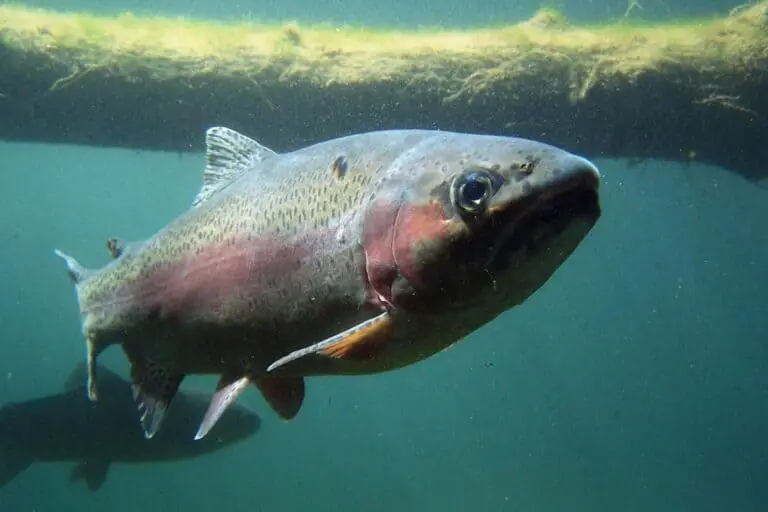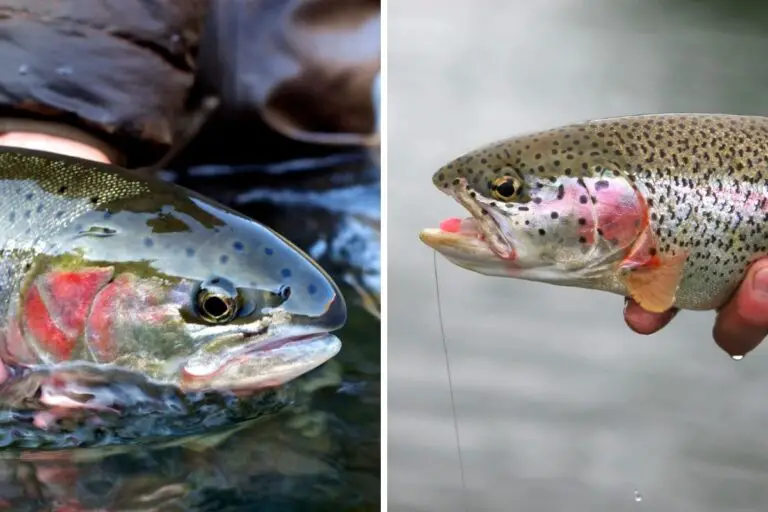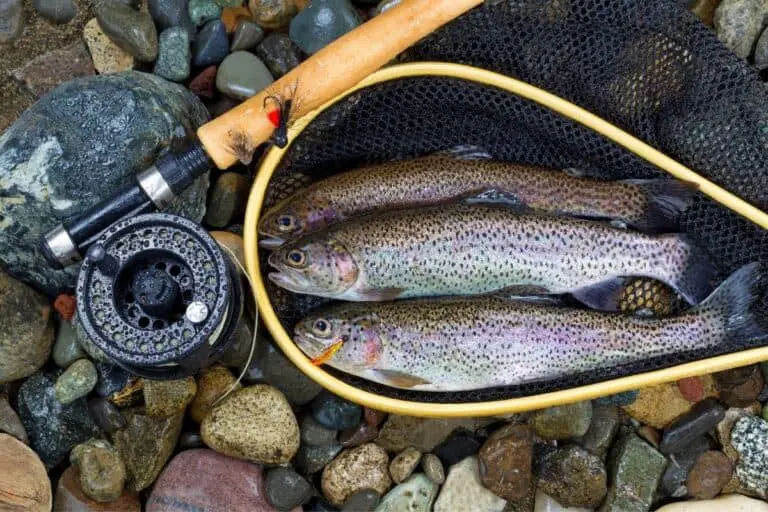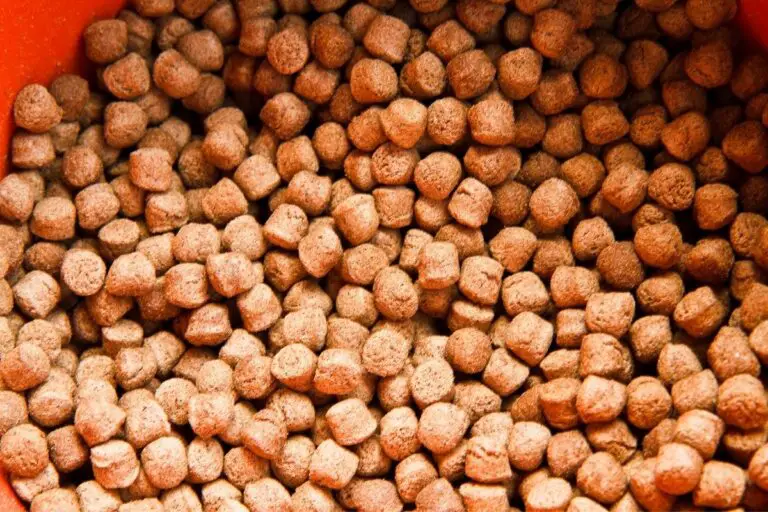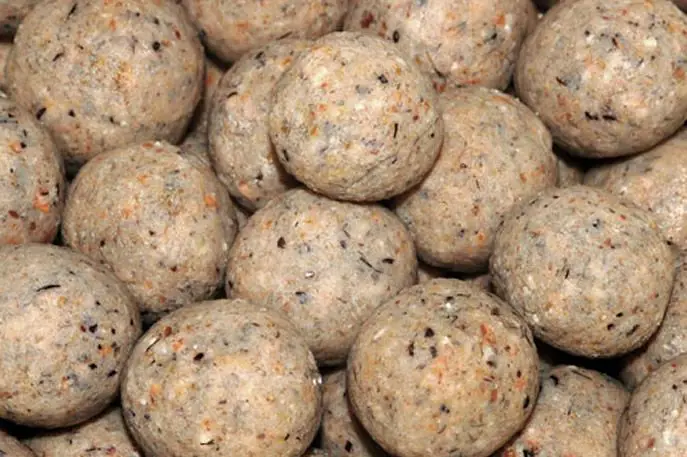Do Trout Bite in the Rain? A Quick Guide with Everything I Know!
Trout is an extremely common type of fish. They are very diverse, but despite that, they are unique. Trout are closely related to the salmon, and anglers love catching them. Likewise, they can usually be found throughout North America, Europe, and northern Asia.
Do trout bite in the rain? Trout bite in the rain. They usually feed more during the rain because they become more active in low light. Although fishing in the rain can be uncomfortable for anglers, it’s definitely worth it as they will have a good opportunity for a catch. It’s best to be prepared with the right gear and techniques for fishing in the rain.
Keep reading to find out more about how rain affects trout fishing and how to catch trout in the rain.
Table of Contents
How Does the Rain Affect Trout Fishing?

Trout normally bite in the rain because they become more active in low light. Usually, when it rains, the weather becomes cloudy, so it naturally dims the light around any body of water that trout swim in. As a result, fishing for trout in the rain can be immensely successful.
The rain also the swimming patterns of trout as it makes the water temperature cooler, so trout tend to rise to the surface, which makes fishing for them easier.
These aren’t the only changes that happen when it rains, however. Rainy days actually have a lot more advantages than you might think.
One of those good changes is that trout aren’t as worried as they normally would be during the day when it comes to their predators. Rain gives trout some cover from predators, so they feel freer to swim closer to the surface.
Some of the trout’s predators include aerial predators as well, such as hawks and eagles. Trout are smart enough to know that rain gives them the exact amount of cover they need in order to be safe enough to swim around freely. Trout usually hide in shady areas during the day to avoid these predators, unlike during the rain.
Another interesting fact to note is that when rain hits the surface of the water, it can create a temperature higher than normal, which causes trout to have a higher metabolism. Rain also brings on unpredictable water currents. Combining two of these conditions can drive trout to feed more aggressively.
How to Catch Trout in the Rain?

So now that we know that fishing for trout in the rain could be a good option, here are some tips on how to catch trout in the rain:
Have Different Types of Bait
The most important thing you can do when trout fishing in the rain is to have many different types of bait. Anglers have stated that one of the best ways to catch trout in the rain is by using scented bait.
Some good bait that can be used is nightcrawlers which are good for all types of trout. PowerBait is also a good alternative when catching trout in the rain. Although artificial, PowerBait has scents that trout are very familiar with, and you can find my picks for the most effective PowerBait for trout here.
Garlic Powerbait

An alternative bait option is the Berkley Garlic PowerBait, which disperses a strong scent in the water that trout can easily detect, and it also masks all other scents that might turn trout away from biting. It’s a must-have trout bait for all anglers.
Have More than One Fishing Rod
Professional anglers have advised you to use more than one rod. Some places might require a license, but it is well worth it. You can check out where you will need a fishing license in this guide.
Fishing with two rods will increase your chances of catching trout in the rain. Usually, anglers will put live bait on one rod and a spinner on the other. That way, if trout don’t bite on your spinner, they will likely bite on it and vice versa.
Keep Moving
To clarify, moving around the body of water where you’re fishing is vital. You want to look for the best place where fish are located. Once you find the right place where trout are bunched up, that is when you can settle and rest, knowing that you will be catching trout soon enough.
Since trout are very diverse, you will find that they locate in different areas at different times. Most types, however, prefer to feed in the rain.
Where to Find Trout in the Rain?
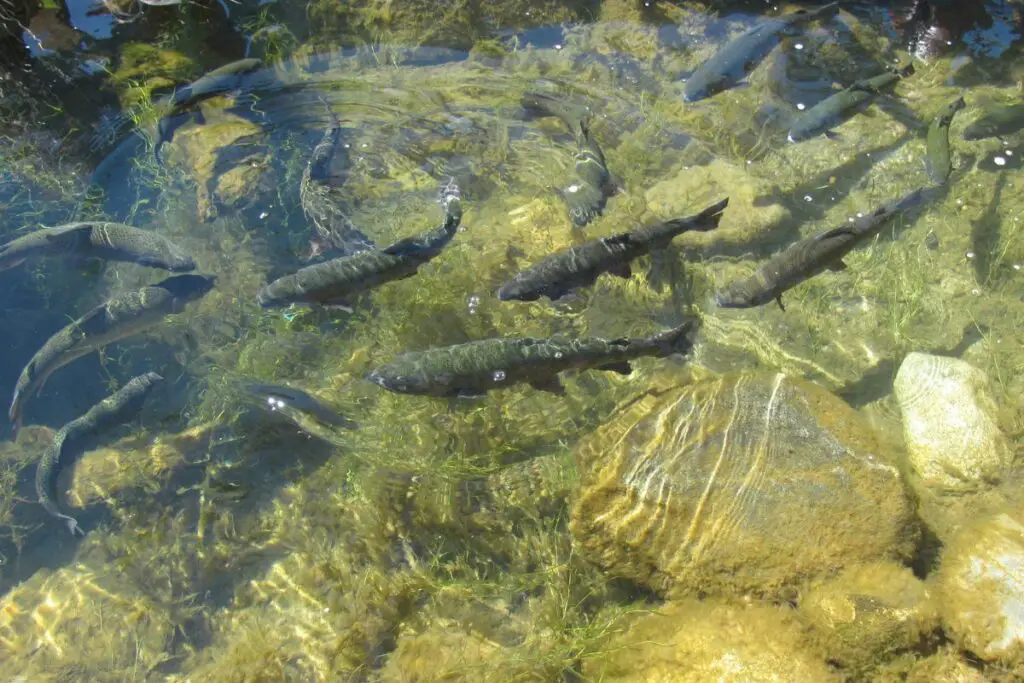
It’s best to search for trouts near banks because trout usually seek water levels that are slower. Still waters are also a great option because trout usually find insects that have washed up from the rain. Fishing in more stable areas can also be much easier for anglers.
Rain can bring on many currents when entering a river or a stream. This will cause the water levels to rise to unpredictable heights, depending on how heavy the rain is. This will cause trout to move from their original spot to a calmer spot in the water.
If you’re fishing around lakes or ponds, it’s best to look around logs, rocks, and any solid platforms that you can find. Trout usually look to feed around those areas without going too much outside of their usual hiding place during the rain.
Similar to rivers and streams, if you’re fishing near a stream or river, you should look near rocks and underneath areas that seem like good hiding places for trout. Among those areas, trout don’t usually struggle to bite. You will probably almost always find some type of trout in that area, depending on what part of the country you’re fishing in.
The only time you should avoid fishing in the rain altogether is when there is a thunderstorm. That can cause major fluctuations in the water temperature as well as in water levels. This is not only uncomfortable for anglers, but trout are also usually scared off by the sudden changes and stop feeding during that time.
Fishing for Trout in Muddy Water
Right after heavy rain, the body of water that trout stay in will probably turn muddy. There are some tips for catching trout in muddy water. It can be a little difficult, but it’s definitely possible. I have a more detailed guide on catching trout after rain that you can check out.
Trout will usually be located around the very bottom in muddy water. So it’s best to not use any type of dry fly. Instead, you can use another type of bait that can reach the very bottom. It’s not advised to catch trout in water that muddy, though.
To indicate how far you need to go to catch trout in muddy water, it’s best to measure that by standing in the mud. If your boots are visible, then the water is good enough for you to fish for trout. On the other hand, if your boots are a murky brown, it’s best to wait for better conditions.
What Kind of Gear Is Needed for Fishing in the Rain?

Apart from knowing the location and time when it comes to fishing for trout, knowing the right equipment is just as important. It could make or break your fishing experience in the rain.
It’s recommended to use a 6-7-foot medium power rod with fast action which will enhance your casting accuracy. Here are my favorite lines for trout fishing. When it comes to the reel, it’s recommended to use a spinning reel. You can check out the best spinning reels for trout here.
There are also several types of lures that can be used to catch trout in the rain. Trout usually do not have the best vision, but they can sense movement, so focusing on vibration-based lures can be a game changer when catching trout under these circumstances.
It’s important to consider gear for yourself as an angler. Having the right type of attire can make your fishing experience more enjoyable as well as tolerable. You will need a sturdy pair of rain boots for your upcoming trout fishing trip.
Hip waders are a good choice for that because they completely cover up your legs, preventing them from getting soaked.
Another thing you’ll need for your person is a fishing vest. A fishing vest is always needed when trout fishing.
They can act as storage boxes without holding you back. They are very reliable, especially ones with Velcro pockets. A good pair of sunglasses and a hat will make your fishing experience even more durable, so it’s important to keep that in mind.
Finally, buying a trout net can become very useful. To look for the right type of trout net, you will need to consider where you’re fishing and how deep you will be fishing.
Nets come in different diameters, so it’s important to do your research before shopping for a trout net. Ones that are made of aluminum are more durable than mesh nets for trout fishing, especially in the rain.
What Are the Best Fishing Techniques for Catching Trout in the Rain?

There are various fishing techniques that will help you catch trout, so let’s take a look at the best one for fishing on rainy days.
Fly-Fishing
Fly-fishing is known as fishing with artificial fly-shaped bait. It is very effective when it comes to fishing for trout. Almost all types of trout are attracted to this type of bait because they usually feed on natural insects.
Some might wonder if fly-fishing for trout is effective during rain, and many anglers will tell you that it is indeed effective as the rain provides some camouflage, and trout know that it’s okay to come out. Seeing flies, which are trout’s natural prey, will tempt them to bite more.
Experienced anglers also stand in the water when they are fly-fishing which provides a better perspective on where the trout might be located. It also helps them predict where the trout might end up. It’s safe to say that anglers are used to getting wet.
There are many types of flies anglers recommend you use if you want to use the fly-fishing technique. Some of these include prince nymphs, bead head nymphs, and leggy nymphs. These are all considered good choices because they look very similar to the trout’s natural prey.
Dry Fly-fishing
Dry fly-fishing is similar to fly-fishing. The only difference is that when you use the dry fly-fishing technique, you only let your artificial fly sit on top of the water and never penetrate beneath.
Dry fly-fishing can be a little tricky, though, when fishing for trout in the rain. The thing you need to look out for when it’s raining is how hard the rain is hitting the water. If the rain is hitting the water too hard, your dry fly can sink into the water, and you would struggle as an angler to catch trout under these conditions.
The best time to use the dry fly-fishing technique is when there is an adequate amount of rain that isn’t too hard to the point where your dry fly will end up getting wet. If you aren’t very experienced with dry fly-fishing, a good alternative for that would be a fishing nymph.
Spin Fishing
Spin fishing is effective at any time of the year, but anglers also use this method during the rain. The right way to do that is by using the right type of lure or by descending their bait underneath the surface and bouncing their bait for trout as a way to lure them in.
Doing this technique correctly can be exceptionally effective when catching trout in the rain. You may want to try out spin fishing in more shallow bodies of water. That way, you can be exact when directing your spinner without having too much trouble.
Lure Fishing
Lure fishing is usually used to attract trout, or any other type of fish, by disguising artificial items as their natural prey. It can be used at any time of the year, as well as when it rains. Anglers love using spinners, and we will help show you how to use them when catching trout in the rain.
There are many types of lures that can be effective when catching trout in the rain. Some of these include spoons, spinners, crankbaits, and jigs. Using any of these three types of lures is a much better option when catching trout in the rain. Using your everyday lure might be good as well if these options aren’t available.
For more information, check out this guide on the best lures for trout.
What Are the Best Baits for Catching Trout in the Rain?

Bait is an extremely important tool to have when you’re fishing for trout at any time of the day, at any time of the year. Fishing in the rain for trout can have some different rules, although most baits that are normally used can be just as effective.
Here is a list of the best bait to use for trout in the rain:
- Nightcrawlers
- Hellgrammites
- Grubs
- Leeches
- Prepacked Trout Bait
- Worms
- Salmon Eggs
- Corn Pellets
- Grasshoppers
- Caddisfly
All these types of bait are usually easily bought. Using these types of bait is very effective when fishing in the rain because they contain some of the same aspects that the trout’s natural prey do. Making sure you use the right hook with any of these types of bait is also essential for catching trout in the rain.
Catching Trout in the Rain with PowerBait
PowerBait can be used when fishing for trout in the rain. Unlike during the night, it is an effective type of bait in the condition of rain. It comes in various colors and can be molded in any shape you look. You just need to make sure you have enough on your hook to be able to weigh your bait down.
PowerBait is sometimes debatable when it comes to fishing for trout in general. Since trout rely mostly on motion during the night, PowerBait might not always be the best option. For more information, check out this guide on the best Powerbait for Trout.
What Is the Best Weather to Catch Trout?

The best weather to catch trout is during the spring. Specifically when water temperatures range from 34-67°F (1-19.4°C). These water temperatures are usually when trout start feeding, just like many other types of fish.
What is the Worst Weather for Trout Fishing?
The worst weather to fish for trout is in the summer. That is usually because trout are very exposed to their predators during broad daylight. Unlike summer, the weather does not usually cool down, and the sun is usually beaming. It’s not common for trout to feed in summer as they do in spring.
Related Questions
When Do Trout Start Biting?
Trout usually start biting in the spring in the early morning until dawn. The second-best time for trout to bite is in the late afternoon. That way, trout aren’t too visible to their predators but can see just enough to start biting.
How to Catch Trout in the Rain from Banks?
To catch trout in the rain from banks, you will need many rods and to soak the right type of bait along the bank of water that trout are currently in. Having multiple baits is also key. Salmon eggs and nightcrawlers are two of the most important baits to use when fishing from banks.
Can You Catch Trout in Cloudy Weather?
You can catch trout in cloudy weather. It is actually an excellent time to catch trout because it provides the dimmed amount of light that trout need to be able to see your bait. In cloudy weather, the sun isn’t too strong for trout. They feel more comfortable roaming and feeding.
Do Fish Know When It’s Raining?
Fish know when it’s raining. The biggest indicator of that is that their feeding habits change. Not only are they smart enough to sense when it’s raining, but they can also tell when air pressure fluctuates. All these factors are important when it comes to fishing.
Outdoorskilled’s Favorite Picks for Trout Fishing
Trout can be tricky, but with the right gear, it can be a lot simpler and a lot easier. After testing dozens of rods, reels, lines, baits, and lures, here are our all-time, tried-and-tested picks for exceptional results with Trout.
The Okuma Celilo rod deserves to sweep my top spot for its 8’6″ model. If you like having extended casting (who doesn’t?), and lightweight rods with high-quality materials, this is the one that will provide your best trout fishing experience ever!
Moreover, it’s also affordable, so even if finances are tight, there’ll be no worries about being able to get yourself some new gear right away – just buy another couple of these babies before they run out!”

As for reels, the Pflueger President spinning reel is a great choice for anyone looking to get the most out of their fishing trip. With an affordable price and impressive features like graphite gears, this reel is the go-to option for all pro Trout Anglers.

As for lines, there’s no better option than the Berkley Vanish for Trout fishing. It’s strong, affordable, and invisible for Trout.

For bait, Scented baits do a much better job of attracting trout, and while you can make your own Scented baits, I believe everyone should at least try Powerbait’s scented baits to see how much of a difference they can make. I recommend testing out the Garlic Power Bait for Trout for yourself first.

Helpful Resources
If you like this article, please share it or pin it, you can find the share buttons below. We will really appreciate it ❤️

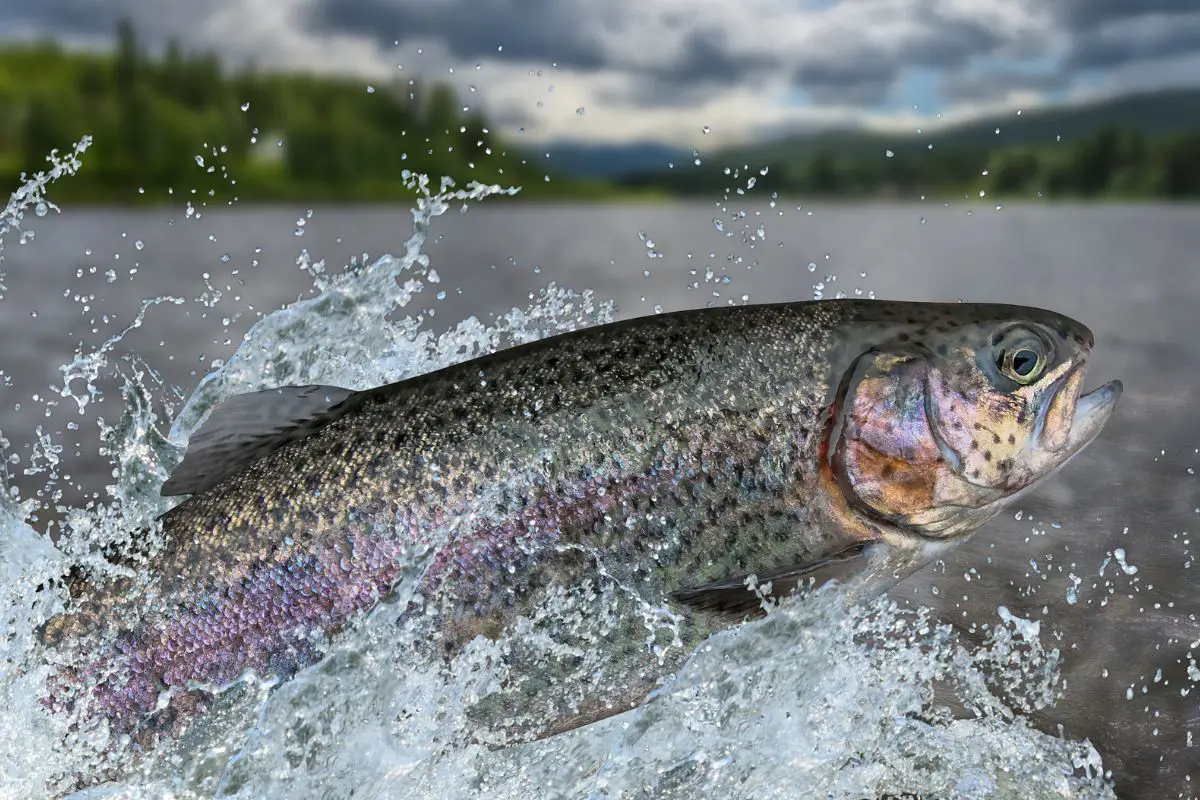
![What Does Rainbow Trout Taste Like? [Tips From A Pro Chef]](https://outdoorskilled.com/wp-content/uploads/2021/11/oven-baked-rainbow-trout-768x512.jpeg)
